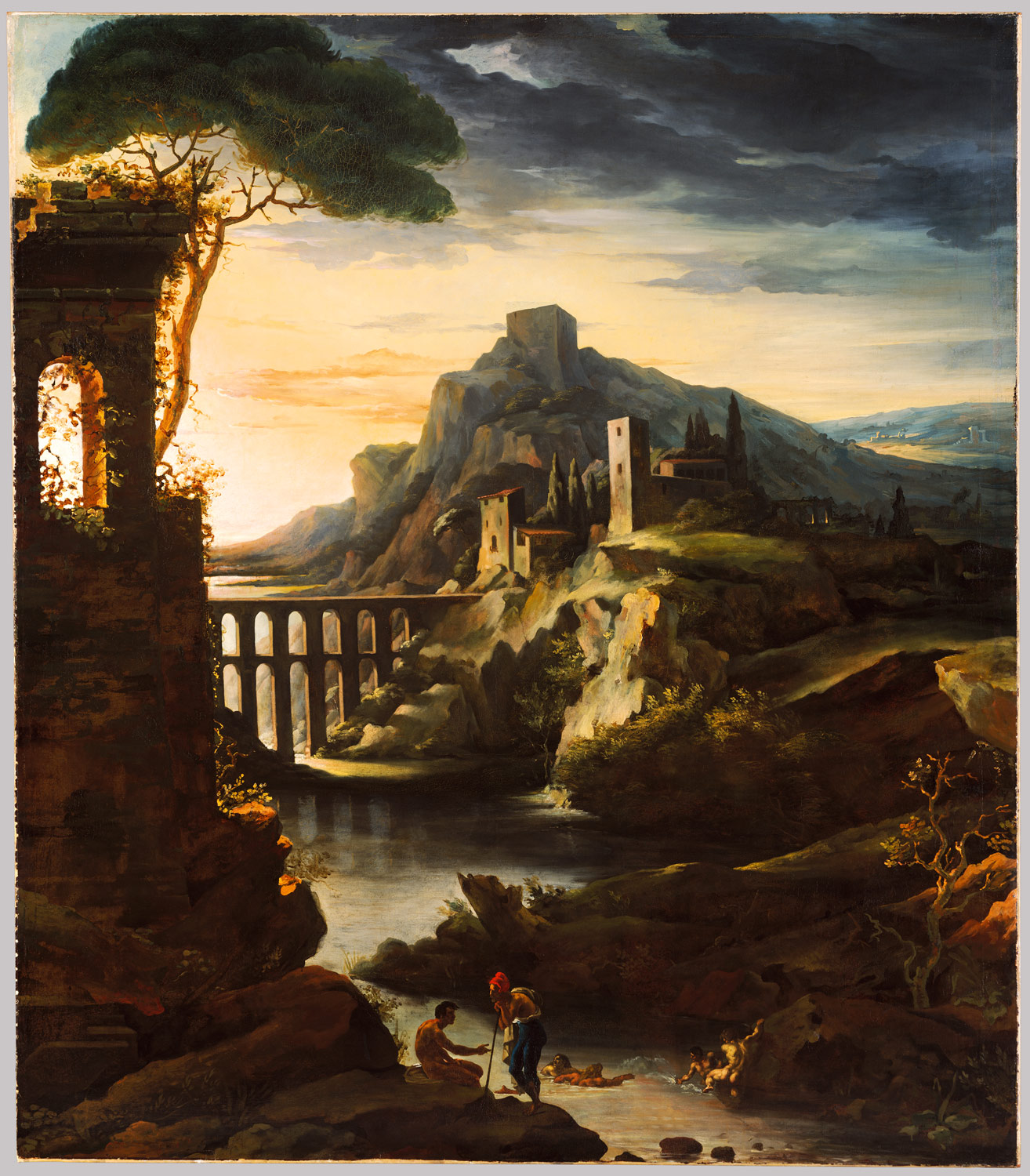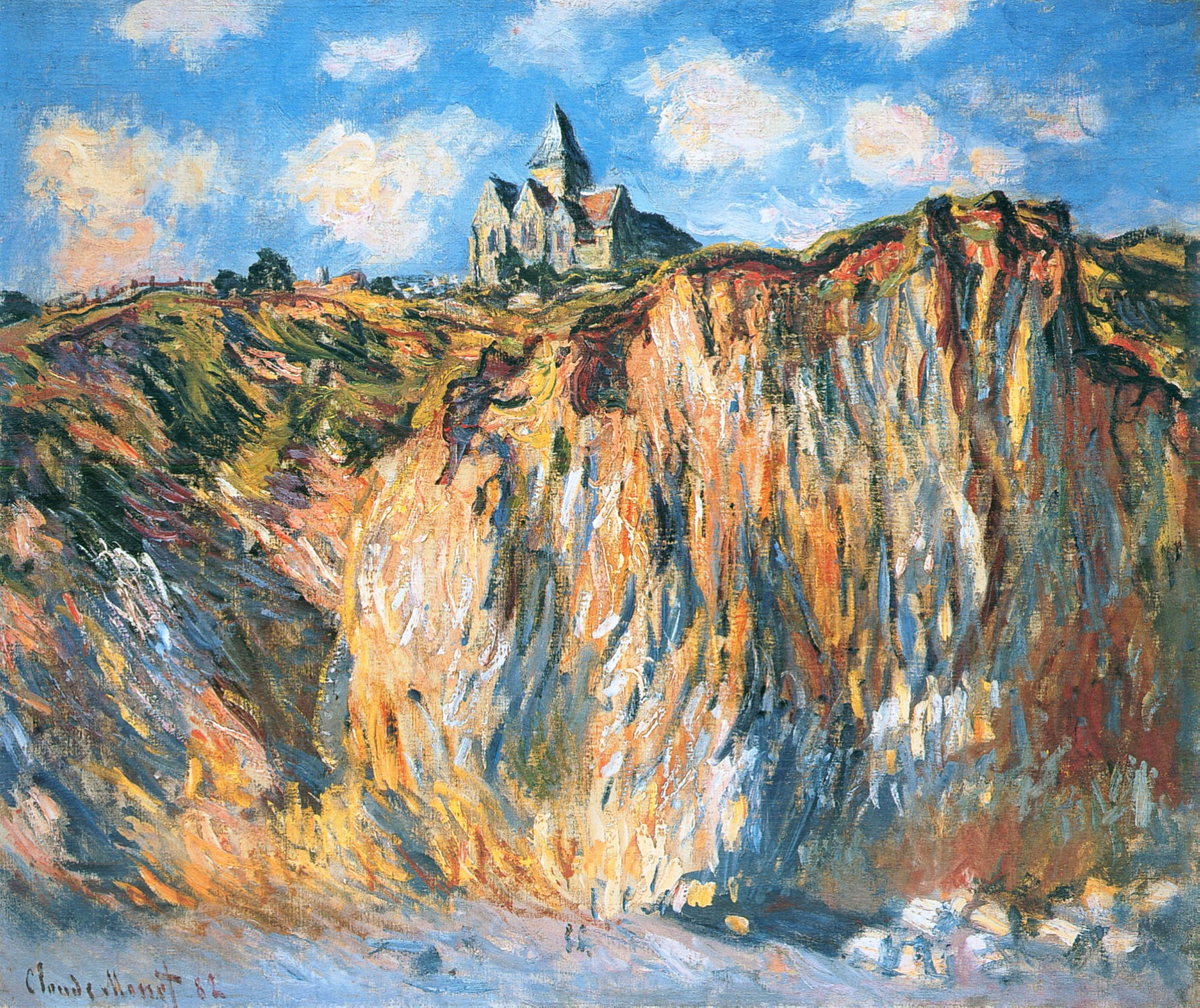In the 19th century, the genre of French landscape oil paintings explored many new styles and techniques, broadening the previously minor genre to the forefront of French art. This collection focuses on the shift away from the Neo-classical style, into the various styles introduced in the 19th century. The styles portrayed, chronologically, were Romantic Neo-classical, Romanticism, Realism of the Barbizon School, Impressionism, Post-Impression, Neo-Impressionism. This progression of style is depicted through one painting each from the following artists, listed in chronological order: Théodore Gericault, Eugene Delacroix, Charles-François Daubigny, Claude Monet, Paul Cezanne, and Henri Matisse.
The centerpiece, Evening: Landscape with an Aqueduct, conveys the most natural contrast of color with a strict attention to realistic detail. The surrounding paintings convey the shift in view of how nature is to be represented, allowing the viewer to focus on the comparison between each time period and the start of this shift at the beginning of the century. The tight orientation of this collection also draws forth the startlingly contrast in the use of color in the different styles, allowing the reader to interpret the emotion that drove artists to pursue these stylistic changes.
The progression of landscape oil paintings is 19th century France illustrate the rejection of neoclassical landscape painting styles in favor of focusing on the imagination and individuality in Romanticism, the en plein air in Realism, the capture of light in Impressionism, the focus on process in Post-Impression, and the explosion of ways to convey daily life in Neo-Impressionism, through the use of vague shapes and the varying contrast levels of color.

Title: Evening: Landscape with an Aqueduct
Artist: Théodore Gericault (French, Rouen 1791–1824 Paris)
Date: 1818
Medium: Oil on canvas
Accession Number: 1989.183
Date: 1818
Medium: Oil on canvas
Accession Number: 1989.183
The shift from Neoclassical to Romantic occurred in the late 1810s, where artists, such as Gericault, began experimenting with how landscapes can convey different emotions, particularly in terms of the use of light (which is explored more in Impressionism). This painting is part of a series of three known paintings (with a suspected forth painting), conveyed landscapes at different times of the day. The dark storm clouds blue clouds and the manner in which the light from the sunset dips and highlights the mountains and river, exemplify the balance of nature and civilization, a trait characteristic of the Romantic period. It also maintains the Neoclassical style of illustrating the grandeur of Roman and Greek sculpture, through the aqueduct and surrounding Roman-style buildings. Its place as the centerpiece constantly reminds the reader of the stylistic techniques of the 18th century, so that the changes in those techniques in the surrounding paintings stand out with greater clarity.
Title: The Sea from the Heights of Dieppe
Artisit: Eugene Delacroix
Location: Musée Du Louvre, Paris, France
Year: 1852
Artisit: Eugene Delacroix
Location: Musée Du Louvre, Paris, France
Year: 1852
Medium: Oil
The Romantic period sought to convey the individuality by maintaining looser brush strokes and increasing the vibrancy of the painting through high contract color execution. This style was the sketch, drawn mostly from memory, so it focuses how on the landscape makes the viewer feel, rather than the exact dimensions. In contrast to the painting of Gericault, this painting adopts a fractured look born of imagination, and a lighter color palette that conveys softness and fluidity. The looser, softer brushstrokes became prominent in the Romantic period for their ability to illustrate dramatic expression.

Title: Riverbank with Fowl
Artist: Charles-François Daubigny
Location: Los Angeles County Museum of Art
Year: 1868
Medium: Oil on panel
Impressionism, born in the 1830s, came from the Barbizon painters. They rejected the idea of idealized or imagined scenes in favor of the naturalist portray of their surrounding landscape. This shift bore the style of en plein air, in which the artist sketched while in the presence of the setting. In contrast, these paintings appeared more naturalist than any of he other 19th century French style, as the artists painted what was there and not their interpretation of it. In this painting, the lack of color vibrancy, in comparison to all the other styles, almost appears dejected, whereas it is actually a more naturalistic rendering of the subject. The focal point of this painting, the trees, stand out in contrast to the rather bland background. Also, unlike Evening, this painting is flat and static, rather than mountainous and dramatic.

Title: The Church at Varengeville
Artist: Claude Monet
Medium: Oil on canvas
Date: 1882
Location: Speed Art Museum
Impression took the plein air style of the romantics, employing it in settings of civilization. More so than the artists of the Romantic Period, impressionists created paintings that had an unfinished appeared, due to the light brush strokes and the lack of rigid detail. In this painting, though not strictly civilization, the majority of the painting is composed of a multicolored cliff that is without specific, lined definition. In contrast to the cliffs of Evening, whose cliffs have definite lines, despite not being the focal point of the painting, the cliffs of Monet, though accurate, have a spontaneous appearance to them, because, unlike those of Evening, they were completed in one sitting.

Title: La Mont Sainte Victoire
Artist: Paul Cezanne
Location: Princeton University Art Museum
Medium: Oil on canvas
Year: 1904-06
Medium: Oil on canvas
Year: 1904-06
Post-Impression completely rejected Impression, in that sketches were looked down upon as artists became more focused on the artistic process of painting, and how one perceives it. Looking back to Evening, and how it was a part of a series, Post-Impression focused on how landscapes appeared different throughout the course of the day, in different light settings. Monet actually began this style, with multiple artworks of the same location at different times of day, but the one above, by Paul Cezanne, focuses on the light source coming from behind the artists, lighting up the mountain. The color vibrancy is heightened with the greater light. The colors of this painting is accurate, but the shapes are softer than they would be naturally. This painting is one of 60 renditions of this exact site, in multiple different lighting. This focuses on the three-dimensional nature of the subject, as each painting focuses on different highlighted areas. This one focused on the front appearance, with the highlighted, shining mountain.


Title: View of Collioure
Artist: Henri Matisse
Location: Hermitage Museum
Date: 1905
Medium: Oil
Neo-Impression is a broad period that incorporated many styles (cubism, fauvism, expressionism, etc.). This painting depicts favism with its vibrant color palette that does not resemble the natural colors of nature. The light purple mountains, and the either blue ground or blue water with houses floating on top. This style contrasts Cézanne’s, who focused on the light on surfaces and structures, and focuses on the importance of color. This painting has minimal definite lines, but rather spots of color characteristic of the Neo-Impressionistic artists. The color palette vibrancy is increased in this painting, as artists believed the viewer mixing the colors heightened the experience.
No comments:
Post a Comment